Florida is famous for its stunning beaches, warm climate, and palm trees. However, many are unaware of a hidden realm of danger concealed beneath the tranquil surface of the state’s lakes and marshes. Home to formidable alligators and venomous snakes, Florida’s waters host some of the most dangerous creatures in the country. Yet, these animals have adapted to thrive in one of the most challenging and unforgiving ecosystems, making them truly impressive. In this article, we will explore the depths of Florida’s lakes and marshes to uncover the most dangerous animals that dwell within.

Are Florida’s Lakes and Marshes Dangerous?
Florida’s lakes and marshes might seem daunting, but they are less dangerous than they look. Alligators, snakes, and other predators indeed inhabit these aquatic environments, yet millions of visitors securely explore Florida’s natural habitats annually. Nonetheless, it is crucial to remain vigilant and adhere to guidelines when venturing into wild animal territories. Moreover, animals such as Florida panthers and black bears that reside near these water sources can also pose a risk to humans.
A List of the Most Dangerous Animals in Florida’s Lake and Marshes
Prepare for a close encounter with several of the most intimidating inhabitants dwelling in the shadowy depths of lakes, swamps, and nearby regions.
Bull Shark (Carcharhinus leucas)
Florida has the highest number of unprovoked shark attacks than any other state. And the quaint coastal town of New Smyrna Beach bears the unfortunate distinction of being the world’s shark attack epicenter. Although most shark species in Florida are not harmful to humans, bull sharks account for most attacks.
Bull sharks are found in warm coastal waters and estuarine along Florida’s Gulf and Atlantic coasts. Their capacity to thrive in saltwater and freshwater environments for extended periods makes them one of the few shark species that can access coastal river systems and sizable lakes. They frequently inhabit shallower waters where people swim.
Despite their notoriety, the majority of bull shark attacks are non-fatal. While they are acknowledged to be territorial and assertive, they do not perceive humans as prey. Instead, they might bite to examine their surroundings or in self-defense when feeling threatened.
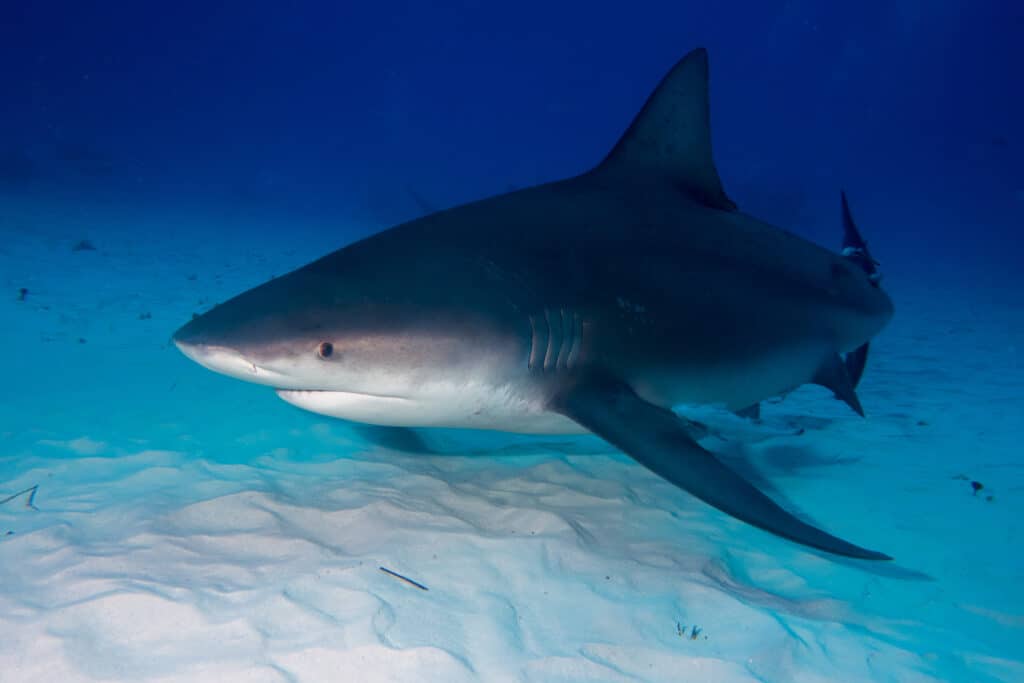
Although most shark species in Florida are not harmful to humans, bull sharks account for most attacks.
©HakBak/Shutterstock.com
American Alligator (Alligator mississippiensis)
When discussing dangerous wildlife in Florida’s lakes and marshes, alligators often come to mind. These sizable reptiles are prevalent in all Gulf Coast states but are especially abundant in Florida. American alligators reside in every Florida county and occupy nearly every freshwater body sizable enough to sustain them. There are estimated to be more than 1.25 million alligators in Florida!
Despite their impressive dimensions and the most potent bite force of any living creature, American alligators are astonishingly non-aggressive. They primarily consume fish and small animals, and unlike some of their kin, they do not regard humans as prey. This is why numerous Floridians and Louisianans, who coexist with alligators, have minimal fear of these predators and even swim in waters where they are present. Alligator attacks on humans are infrequent.
However, it is crucial to recognize that these are powerful predators capable of causing human fatalities. Since 1948, there have been 442 unprovoked alligator attacks, of which only 26 were deadly. American alligators exhibit the highest aggression when safeguarding their nests; a mother alligator will defend her offspring valiantly. Alligator nests are large mounds of soil and vegetation built near the water’s edge, so it is advisable to steer clear of them if encountered.
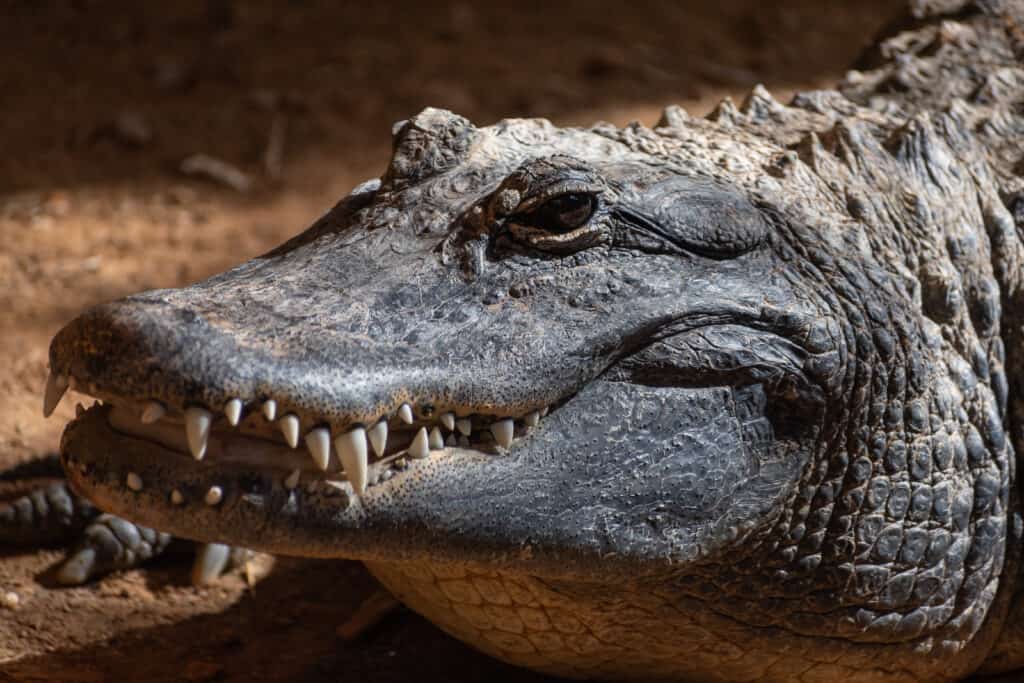
American alligators reside in every Florida county and occupy nearly every freshwater body sizable enough to sustain them.
©iStock.com/CoinUp
American Crocodile
The American Crocodile is only found in the southern part of Florida in the United States. Crocodiles look very similar to alligators, with a few key distinctions. Crocodiles are larger. They can weigh up to double the weight of an American alligator. Crocodiles also have a v-shaped snout, while alligators have a u-shaped snout.
In the 1970s, American crocodiles were endangered in south Florida, with the estimated population being only around 300. However, now scientists estimate there to be nearly 2,000 crocs in the state! Even with this impressive increase in population, you are MUCH less likely to encounter a crocodile in Florida than an alligator.
Crocodiles are more aggressive and dangerous than alligators. Crocodiles have the 2nd strongest bite force out of any animal in the world. They are definitely among the most dangerous animals in Florida’s lakes and marshes. You definitely don’t want to find yourself anywhere near their jaws. Crocodile attacks are also 100 times more common than shark attacks worldwide. So while many are scared of sharks when swimming, it is more reasonable to be scared of crocodiles.
Don’t let these statistics scare you, though. In Florida, there have not been any recorded Crocodile attacks.
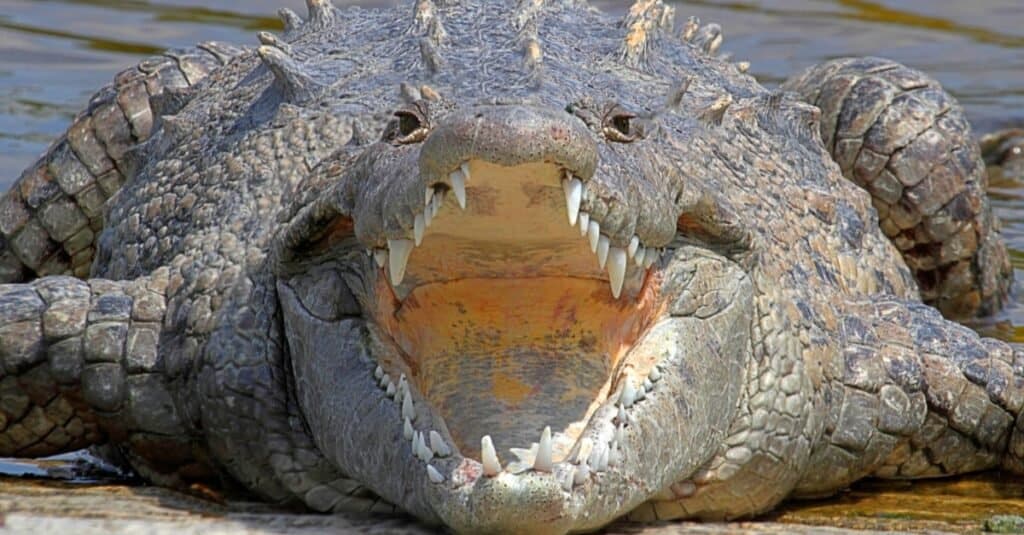
The American Crocodiles are only found in the southern part of Florida in the United States. They have the 2nd strongest bite force out of any animal in the world!
©iStock.com/SteveByland
Florida Softshell Turtle (Apalone ferox)
Florida softshell turtles are widely distributed across Florida. They inhabit various aquatic environments like ponds, marshes, streams, and even drainage ditches. They typically prefer muddy or sandy areas as their habitat.
Despite their somewhat benign appearance, Florida softshell turtles are actually an aggressive species and are known to bite. In fact, they display aggression not only toward predators or humans but also towards each other. They have a very strong bite which can be quite painful, with larger adults capable of even taking off a finger. Even young Florida softshell turtles can deliver a painful bite that draws blood, leaving a deep mark or scratch on the skin.
It’s worth noting that the Florida softshell turtle does not have teeth; instead, it has a sharp, horny beak that it uses for attacking. Florida softshell turtles may bite for several reasons, such as feeling threatened, being handled by humans, or when hungry during feeding. Given this, if you come across a softshell turtle in the wild or near a freshwater source, it’s best to avoid picking it up or disturbing it in any way.
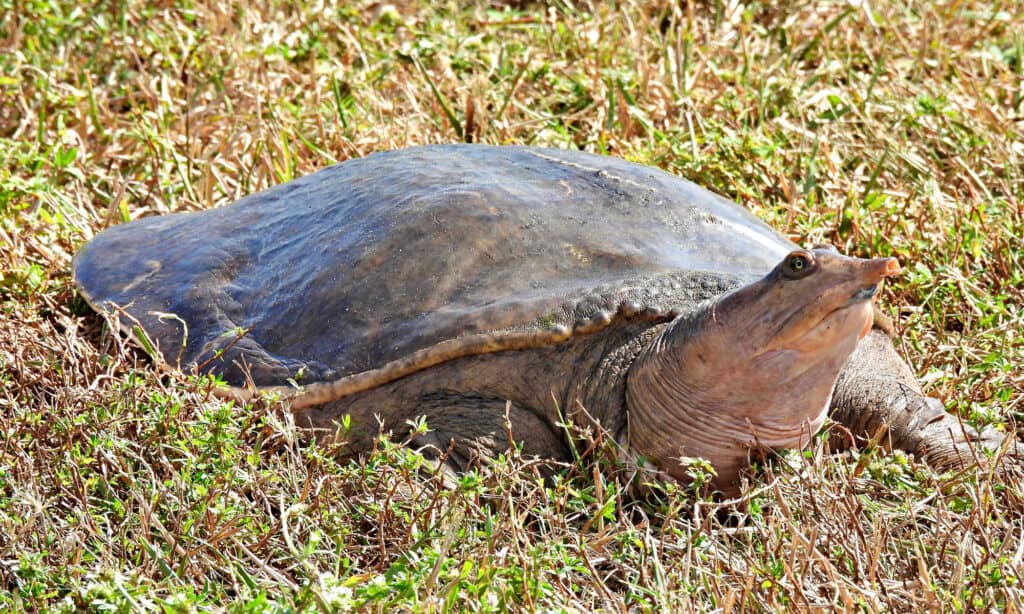
Despite their somewhat benign appearance, Florida softshell turtles are actually an aggressive species and are known to bite.
©iStock.com/passion4nature
Snapping Turtle
There are two species of snapping turtle in Florida, the common snapping turtle and the alligator snapping turtle. They look fairly similar, but alligator snapping turtles have rougher shells and bigger heads, and are noticeably larger in size.
Common snapping turtles live mostly in the southern regions of Florida, while alligator snapping turtles live in the northern and panhandle region.
Despite common snapping turtles looking slightly less menacing, they actually have a stronger bite than alligator snapping turtles. However, I would recommend steering clear of either species.
The alligator snapping turtle is the largest freshwater turtle in the United States and can weigh up to 250 pounds! These massive predatory turtles have a large sharp beak-like mouth with one of the strongest bites in the animal kingdom. They can easily bite through bone and take off fingers with their powerful bite.
These creatures thrive throughout Florida in freshwater lakes, streams, and ponds. They feed on fish, snakes, other turtles, and even baby alligators! They have an extremely hard-pointed shell that grows as the turtle ages. Alligator snapping turtles have a lifespan of up to 70 years!

The alligator snapping turtle is the largest freshwater turtle in the United States and can weigh up to 250 pounds!
©iStock.com/Sista Vongjintanaruks
Cottonmouth (Agkistrodon piscivorus)
Cottonmouths, also known as water moccasins, are one of the most encountered snakes in the state of Florida. They occupy various wetland environments, such as lowland swamps, lakes, rivers, and marshes, where they search for their favored prey, including frogs and fish.
Cottonmouths have the ability to bite underwater in order to capture fish, which is essential for their survival. Contrary to popular misconceptions, these snakes typically evade human interaction and only resort to biting when they perceive a threat. Cottonmouths are particularly common in forest ponds. They emit a distinctive smell similar to a skunk, so if you are near water and smell an especially foul smell, keep your distance! These snakes possess thermal sensors that aid them in locating food.
Although non-venomous water snakes might resemble cottonmouths and display assertive behavior, they are not dangerous to humans. Conversely, cottonmouths are venomous and can pose a risk to people and pets if bitten. These snakes will generally try to flee if they detect danger, but if cornered, they may exhibit their striking white mouth as a defensive stance.
In the event of a cottonmouth bite, it is vital to seek prompt medical assistance from a qualified physician or hospital experienced in addressing snakebites.

Cottonmouths, also known as water moccasins, are one of the most encountered snakes in the state of Florida.
©iStock.com/Saddako
Dangerous Animals Around Florida’s Lakes and Marshes
Although not living within lakes and marshes, these dangerous animals can still be found prowling in the vicinity.
Eastern Diamondback Rattlesnake (Crotalus adamanteus)
The eastern diamondback rattlesnake is a native Florida species famous for its formidable size and venomous bite. The snake inhabits various areas of Florida, including coastal forests, pine and wiregrass, scrublands, and barrier islands. It is one of the most dangerous animals in Florida’s lakes and marshes (and in the world) due to its venomous potency.
When threatened, the snake coils its anterior half in an S-shape and can strike up to one-third of its body length. Although some may stand their ground and strike repeatedly, most will choose to retreat while facing the intruder and moving backward toward safety.
Contrary to popular belief, the eastern diamondback rattlesnake does not necessarily have to rattle before striking. It is capable of attacking silently, so it is essential to be vigilant around this snake.
The venom of the eastern diamondback rattlesnake is a potent hemotoxin that destroys red blood cells and damages tissues. Their bites can be fatal to humans, but antivenom is readily available throughout thesnake’ss habitat.
In the entirety of the United States, there are nearly 8,000 rattlesnake bites each year, of which only 10-15 result in death.
If you encounter an eastern diamondback rattlesnake, remaining calm and collected is crucial. Refrain from panicking, screaming, or running away. Instead, freeze, take deep breaths, and move away slowly if you’re within three feet of the snake’s range. You must not to make any sudden movements, as this can provoke an attack.
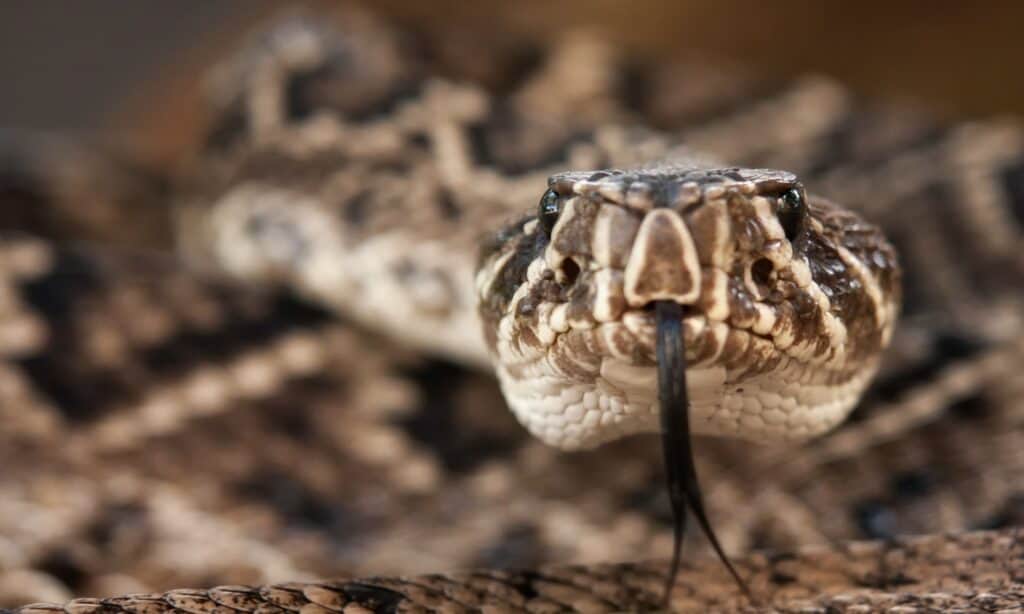
The eastern diamondback rattlesnake is a native Florida species famous for its formidable size and venomous bite.
©iStock.com/Wide-River-Rick
Florida Panther (Puma concolor coryi)
In Florida, two native feline species exist, the Florida panther and the bobcat. The Florida panther prefers to hunt and rest in areas featuring dense vegetation and favors pinelands, forested regions, and mixed freshwater swamp forests.
Florida panthers are recognized for their curiosity and may watch humans for extended durations. This behavior is not dangerous and does not suggest that the panther has lost its fear of humans. Generally, the panther does not regard humans as prey and opts to avoid interaction with them.
Although no recorded instances of a Florida panther attacking a human exist, it is still a potentially dangerous animal. In western states, where cougar attacks are more common, people have successfully defended themselves against these predators using a variety of tools such as sticks, rocks, caps, garden tools, jackets, and with hands.
The Florida panther exhibits a bite force of approximately 400 pounds per square inch and possesses 30 teeth, including elongated canines for tearing flesh and robust premolars and molars for crushing bones.
If you come face to face with a Florida panther, the FWC advises standing tall and facing the creature, maintaining eye contact, and doing everything feasible to appear larger. It is also crucial to refrain from crouching or bending down, running or turning away from the panther, and to fight back if attacked.

Although no recorded instances of a Florida panther attacking a human exist, it is still a potentially dangerous animal.
©jo Crebbin/Shutterstock.com
Wild Boar (Sus scrofa)
Wild boars are present across all 67 counties in Florida. They can live in various environments, such as freshwater marshes and sloughs, oak-cabbage palm hammocks, agricultural regions, and pine woods. Though not native to Florida, they have resided there for centuries and might have been introduced by Spanish explorers in the early 1500s.
As the wild boar population expands, the likelihood of human-wild boar conflicts increases. They may roam into parks, public roads, and residential zones. While wild boars may appear shy, they remain wild creatures and can act unpredictably, posing a threat to public safety.
Like many wild animals, wild boar will not hesitate to attack if cornered or feeling endangered. Female wild boars are highly protective of their offspring. These animals are powerful and capable of running at considerable speeds. Adult male canines can inflict severe wounds during an attack. Their sturdy build makes them particularly hazardous in car collisions. Consequently, the unmanageable growth of the hog population has led the government to declare year-round open season on them in Florida, with no kill limits.
Wild hogs rarely attack humans. In the United States, merely four individuals have perished from feral hog attacks since the late 1800s, with three of the casualties being assaulted by injured boars during hunting. Therefore, it is highly improbable that a wild hog will harass or pursue you. However, if threatened, you must defend yourself.

Though not native to Florida, wild boars have resided there for centuries and might have been introduced by Spanish explorers in the early 1500s.
©Martin Mecnarowski/Shutterstock.com
Florida Black Bear (Ursus americanus floridanus)
Florida black bear is the only bear species found in the state. In Florida, the estimated population of these bears is around 4050. These bears inhabit various environments, including flatwoods, swamps, scrub oak ridges, bayheads, and hammocks, where they seek food, water, and suitable shelter within their home ranges.
Although Florida black bears have not been documented preying on humans, instances have occurred where individuals were bitten or scratched by bears while defending themselves, their cubs, or their food sources. Black bears may also display defensive behavior if feeling threatened, particularly when they become aware of a person’s presence.
In contrast to their larger and more aggressive relative, the grizzly bear, black bears are not considered as dangerous to humans. However, it may attack if a black bear feels cornered or trapped. This is particularly true for mother bears. They are protective of their cubs and may attack if they sense their young are in danger.
Black bears are renowned for their speed and adeptness at climbing trees rapidly. Despite their remarkable abilities, they tend to utilize their speed and climbing skills to evade humans rather than pursue them. In reality, humans pose a much more significant threat to black bears in Florida than the bears do to people.
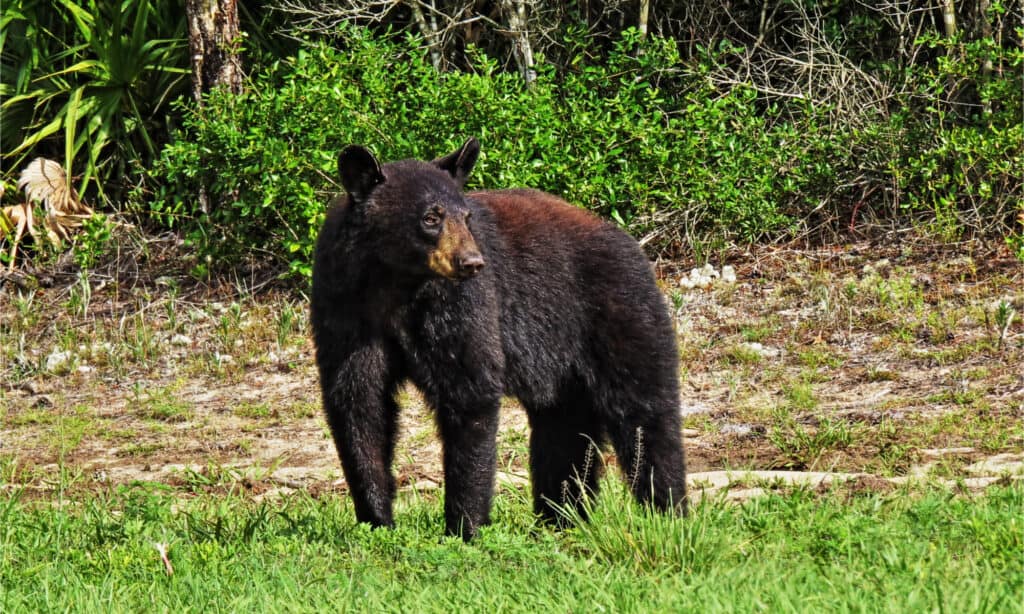
Florida black bear is the only bear species found in the state.
©Roger Epps/Shutterstock.com
The photo featured at the top of this post is © Willyam Bradberry/Shutterstock.com
Thank you for reading! Have some feedback for us? Contact the AZ Animals editorial team.






